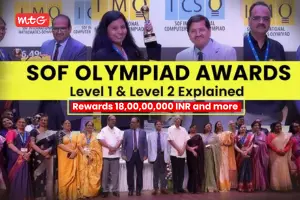Here is the SOF NSO Level 2 sample paper for Class 5 and solutions for each question. Practicing this sample paper multiple times will help students recognize the most important topics for the exam. With a total no of 10 questions to practice, It will help to enable and identify strengths and weaknesses, allowing them to focus more on weaker areas to perform well in the upcoming NSO Level 2 exam. To access the NSO Class 5 sample paper, use the link provided below to enhance your exam preparation.
NSO Level 2 Sample Paper for Class 5
Find the Answers below….
Recommended NSO level 2 Class 5 Study Material
The NSO study material includes the curriculum syllabus of ICSE/ISC, CBSE, and State Boards. To excel in NSO exams, students should be familiar with the syllabus of all three boards for class 5 students. In addition to the curriculum followed by the boards, there are various NSO study materials available for students to study from.
- Class 5 NSO Power Pack – Level 2
- Class 5 NSO Power Practice Pack – Level 2
- Class 5 NSO Olympiad Online Classes – Level 2
- Class 5 NSO All India Online Mock Test Series – Level 2
- Class 5 NSO Olympiad Skill Development System (OSDS) – Level 2
- Class 5 NSO Previous 4 Years Papers (Instant Download eBook) – Level 2
SOF Level 2 Exam Schedule
The second level Olympiads will be conducted on Sunday 11th February 2024 as per the following schedule:
| EXAM | TIMINGS |
|---|---|
| SOF International English Olympiad | 9.00 am to 10.00 am |
| SOF National Science Olympiad | 11.00 am to 12.00 Noon |
| SOF International Mathematics Olympiad | 1.00 pm to 2.00 pm |
SOF NSO Level 2 Class 5 Marking Scheme
The marking scheme for NSO level 2 Class 5 is as follows.
| Class | Topic/Section | No. Of Questions | Marks Per Question | Total Marks |
| 5th Standard | Science | 45 | 1 | 45 |
| Achievers Section | 5 | 3 | 15 | |
| Grand Total | 50 | 60 |
Answer Keys
1- (B): The body of fish and reptiles (for example, snake, crocodile, lizard) is covered with a layer of hard and overlapping structures called scales. It prevents water loss in reptiles.
2- (C): In all the given options, animals are classified on the basis of their eating habits. Human, rat and squirrel are omnivores. While rabbit is a herbivore, so rabbit should be encircled.
3- (D): The diseases which can spread from one person to another are called communicable diseases e.g., typhoid, plague, measles, chicken pox, malaria, cholera, etc.
4- (A): Proteins help in growth, repairing the tissues of the body and in healing small cuts and wounds. Milk, eggs, meat, soybean, fish and pulses are rich in proteins
5- (A): The crops which are grown from June to October (summer) are called kharif crops. These crops depend largely on the monsoon rains. Examples are rice, maize, millets, bajra, jowar, etc. Wheat is a winter crop or rabi crop.
6- (D): Sedimentation is the method in which insoluble impurities like sand are separated from the water. The rate of sedimentation is increased by adding special chemicals such as alum. This process is called loading. Alum particles attach themselves to the dirt particles suspended in muddy water, making them heavier. The dirt particles settle down easily at the bottom of the container and clean water is obtained.
7- (C): The given figure shows the water droplets on the base of the lid. The change of water vapour (gas) into water (liquid) is called condensation
8- (C): In the given chart P represents mechanical energy. W is potential energy and X is kinetic energy. Y represents magnetic energy. Z is natural source of energy and can represent solar, geothermal and wind energy. Heat energy comes from burning fuels like coal, kerosene and petrol and is not a natural source of energy.
9. (D) : The intensity of tides vary with the phases of the Moon. The highest tides occur at the time of the New Moon and Full Moon. The given figure shows, New Moon is on the 5th March and Full Moon is on the 19th March, so highest tides are seen on 5th and 19th March.
10- (D): For germination, seeds require air, moisture (water) and warmth. As seeds kept on dish ‘S’ are getting air, water and warmth, therefore, these seeds will germinate.
This concludes the comprehensive discussion on the SOF NSO Level 2 Sample Paper for Class 5. We hope that the information provided in this article proves to be beneficial for students’ studies. Stay connected with MTG for the latest SOF Olympiad Level 2 exam updates.































